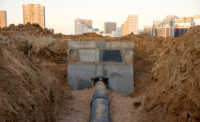From the Editor | Natalie Forster
Hurricane Helene acts as reminder of water infrastructure importance
Historic flooding leads to thousands left without power and clean water.

Image Source: shaunl / E+ via Getty Images
As I am writing this column, thousands of people from the Florida coast up to the Carolinas are still stranded without power, drinking water or a safe way to access basic resources due to the catastrophic flooding brought on by Hurricane Helene.
Helene made landfall in Florida on Thursday September 26th and worked her way up the Southeast, completely devastating numerous cities. As of Monday September 30th, Helene’s death toll is believed to be at 116, with at least more than 600 more individuals unaccounted for. Our thoughts and prayers go out to all of those affected by this massive tragedy.
As a born North Carolinian, I am heart-broken for the Boone and Asheville and surrounding North Carolina towns who experienced record-breaking floods after Helene dumped more than 30 inches of rain in rural areas that are not equipped for this type rainfall. Many of these mountain towns destroyed by Helene are areas that already lacked resources and access.
The topography of the mountains in this area is largely to blame for the devastating floods, but according to Art DeGaetano, director of the NOAA Northeast Regional Climate Center at Cornell University, climate change and lack of proper infrastructure are to blame as well.
The warm waters from the Gulf of Mexico helped the storm absorb even more moisture and intensify as it neared the coast, and human-amplified climate change is causing more frequent and intense extreme rainfall events, according to the federal government's Fifth National Climate Assessment.
DeGaetano explains that many places along the East Coast have experienced an overall increase in rainfall due to climate change. "According to the National Climate Assessment, extreme precipitation events have increased by about 37% in recent decades in the Southeast," he says.
As we know throughout the PHCP-PVF industry, many areas of the country, in particular rural cities like the ones in North Carolina impacted by Helene, lack the type of infrastructure that can handle this heavy rainfall.
Each time a natural disaster like this strikes, I am reminded how imperative it is our country invests in its infrastructure. Just like the Texas Freeze of 2021, Helene showed us that natural disasters are unpredictable — increasingly so due to climate change — and can strike an area of the country not equipped for the aftermath. Rural Western North Carolina doesn’t have infrastructure even close to strong enough to handle this type of rainfall.
The backbone of making improvements to our country’s infrastructure lies in our industry. Our products, innovation and training provide the tools needed to make the improvements nationwide that will help better prepare communities for flooding and freezing, once government funding is allocated correctly to attack the country’s infrastructure problem.
It’s not just municipal waterworks either; our industry is constantly creating products that provide and conserve clean, safe water, something we often take for granted until a disaster like this strikes.
All people in all communities deserve access to clean and safe sanitation and water, and we all deserve infrastructure that supports our growing communities. This is your reminder that the work you do every single day matters. If you live in an area collecting donations for Hurricane Helene victims, please consider gathering donations from your team to help these people rebuild their communities.
Looking for a reprint of this article?
From high-res PDFs to custom plaques, order your copy today!






